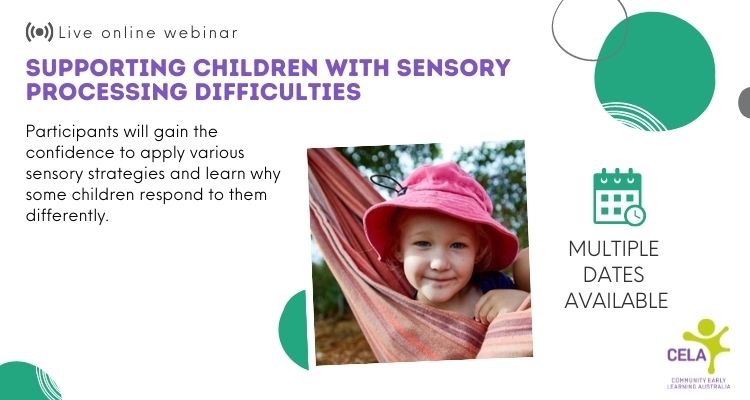Imagine sitting in a circle with your preschool friends who are listening intently as an educator reads We’re Going on a Bear Hunt. They’re enjoying the story but all you can focus on is the itching sensation around your neck caused by your thick winter pullover. You just don’t have the words yet to tell your educators how much it bothers you, and you don’t know how to remove it. All you can think to do is cry and scratch, and it’s making you feel miserable and frustrated. This is the experience of a child with clothing sensitivities.
We speak with Paediatric Occupational Therapist Laura Petix about how to support children experiencing sensory clothing issues.
For children with sensory clothing issues, sensations that may be unnoticeable to us are unbearable to them. The tag on a t-shirt, the seam on a pair of shorts, or even the fuzziness of socks can impede a child’s ability to function in important activities. For educators and parents, this can create hygiene or safety challenges and risk obstructing a child’s opportunity to play or learn.
If a child has issues with clothing, do they have a sensory processing disorder (SPD)?
Throughout our busy days, our brains are constantly receiving information about our environment through our senses. The coffee we smell, the traffic we hear, and the clothing we touch all send signals to our brain which then registers the information and decides if a response is necessary and how to react.
The concept of sensory processing difficulties was introduced by Dr. A Jean Ayres in the 1970s, after identifying that some brains were unable to regulate all of this incoming information in the same way that many of us take for granted.
Whilst many of us have unique sensations we may not like, such as the sound of nails on a chalkboard or the feeling of a cotton ball, an SPD can hinder the daily activities and interests of a person. When a child’s sensory clothing issues negatively impact their social interactions or education opportunities, it may be indicative of a Sensory processing disorder.
A child who has a clothing sensitivity is considered to have a low threshold for tactile input, meaning they register tactile input at a higher rate than neurotypical people,” explains Paediatric Occupational Therapist Laura Petix.
SPD Australia states that SPD affects the functional skills of 1 in 20 children. A common misconception around SPD is that it is just another name for ADHD or a form of autism spectrum disorder. Whilst there may be many overlapping symptoms, this is incorrect. SPD, and clothing sensitivities in particular, can impact any person at any age regardless of whether they also have these disorders.
What are some signals indicating a sensory clothing issue?
According to Petix, children with sensory clothing issues can sense every seam, wrinkle or fuzz ball in a sock. They are extremely irritated by tags. They may not be able to tolerate clothes that fit them and rather prefer clothes that are too tight or too big. In extreme cases, some children cannot tolerate wearing underwear at all or socks or shoes. She identifies some signals educators can be aware of that may indicate clothing sensitivity issues. It is important to note that these signs do not definitively determine an SPD and each child’s situation should be considered individually.
Clothing Challenges in Sensory Sensitive Children via Instagram @theotbutterfly
Some signals in children could include:
- Being particularly fidgety or unfocused and continually playing with or adjusting clothing.
- Refusing to play dress up games when given the opportunity.
- Regularly wearing a “uniform” of the same clothing and exhibiting agitated behaviour if they deviate from this clothing.
- Wearing clothing that is not appropriate for the weather or is the wrong size.
How can we best support a child experiencing sensory clothing issues?
As sensory issues can lead to educational, social and emotional challenges for children, it is crucial to understand the effects of sensory issues. Their behaviourisms are at risk of being negatively misinterpreted, including labels such as disruptive, impulsive, immature, or belligerent.
Here are some helpful tips for parents and educators supporting a child with clothing sensitivities:
- Find clothing without tags in or remove the tags.
- Use clothing with super soft fabrics or natural materials—synthetic blends can be uncomfortable to sensitive children.
- Allow plenty of time for the child to get dressed so they can become familiar with the sensation of each fabric on their skin.
- Try to purchase multiple items of the clothing that the child finds comfortable.
- Have heavy clothing or blankets available for children who find comfort in a “cocoon” feeling.
- Avoid clothes with difficult fasteners—velcro and drawstrings will keep children from getting frustrated and worked up overt tricky tasks like buttons and tying.
- In sensory sensitive children, dirty or wet clothing can trigger dysregulation, so always have extra clothing on hand.
The best way to support a child with sensitive clothing challenges is to work with them and support them in their sensory needs rather than work against them," says Petix. "Allow them to feel comfortable, which will enable them to focus better on what they are doing.
Check out Laura Petix (The OT Butterfly) and other resources on sensory processing challenges below.
Further reading:
The OT Butterfly – Paediatric Occupational Therapist Laura Petix
Child Mind Institute – Sensory Processing Issues Explained
SPD Australia – Supporting and advocating for people with Sensory Processing Disorder
CELA professional development relating to this topic

FIND OUT MORE
About CELA
Community Early Learning Australia is a not for profit organisation with a focus on amplifying the value of early learning for every child across Australia - representing our members and uniting our sector as a force for quality education and care.